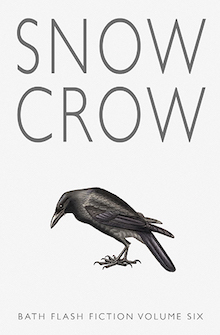
Ad Hoc Fiction, 2021
“And the days were made of auguries.” So begins Snow Crow, the sixth anthology of the best flash — short stories of three hundred words or less — from last year’s Bath Flash Fiction Award. Selected from a pool of nearly four thousand entries from sixty-four countries, Snow Crow collects a hundred and thirty-six stories in a compact volume with an intense coherence. The stories bear passionate witness to the suffering and loss of the Covid-19 pandemic, particularly its confusing early days when information was scarce and the internet produced innumerable auguries from sudden prophets of all kinds, from epidemiologists and virologists to that one guy who made a widely shared video explaining how to disinfect groceries.
In Snow Crow’s title story, by Doug Ramspeck, a boy is storing a dead crow in his closet. The boy’s world has become tiny, and he’s tightly enclosed within it. Living under a kind of lockdown, he only knows what he can see and hear from inside his room.
And the cricket calls arrived disembodied from the field. And a dead mole lay on its back by the garage, gathering its thin blanket of ants. And wasps hummed outside the boy’s window like primitive wraiths.
“Snow Crow” ends with a fabulous gesture: “And on the evening when a first light snow of the season came dropping toward the land, the boy carried the crow back into the woods and tossed it high as he could manage into the air.” The boy returns the crow to the sky, but his wild gesture does not bring it back to soaring life. This ending reads like a parable of our present moment, shot through with the understanding that although we may be returning to our social lives, the pre-pandemic world will not return with us, no matter how badly we wish for it.
The stories collected in Snow Crow snatch freighted moments from the flow of time and enlarge upon them, inviting the reader to look more closely, to feel more fully. In Slawka G. Scarso’s “Meeting the parents in five minutes,” a doctor stands in a hallway preparing to convey bad news to parents beyond the door. A passing nurse does a double-take, and he sees that he’s already communicating: “She knows. The way you can tell when someone is bringing bad news. The way they’ll know when I’ll open the door, and they’ll see me at last … They’ll know without me uttering a word.” Lingering over this moment of recognition, Scarso brings the narrator’s private decision to delay into the reader’s experience of the story, prolonging the moment before his terrible news shatters the family: “Just a couple more minutes now. Just a couple more minutes until they know.”
Many of the stories have a reparative thrust, reminding readers that, at least in imagination, even terrible damage can be undone. Imagination can restore symbolically what has been broken in reality. In Anne Summerfield’s “Her Love the String,” an anatomy student dissects a heart and is reminded of her father’s sudden death. She “thinks of body blows, cardiac rupture. And then, in her mind’s eye, she stitches her father together, mends him like a torn ragdoll, his ventricles taught and blood-tight, her love the string.” Pulsing with a thousand tiny labors of reparation, the stories collected in Snow Crow provide a clear-eyed reminder that grief actually is work. In Anne Howkins’ “When Everything Is Done,” a town has burned down and the survivors are taking stock: “We retrieved long bones, short bones, rounded skulls … we lay out the bones of family trees where houses had been.”
The image of thwarted launch — that dead bird flung into the air — repeats throughout Snow Crow. But these stories aren’t despairing; rather, they demonstrate a fierce attachment to visionary imagination, to storytelling, as essential to navigating catastrophic loss. In Tom O’Brien’s “Shadow of a Man,” a prisoner passes time by playing shadow puppets, using his hands to cast shadows on the wall until his dream of escape literally takes wing: “With his big knuckled hands Ed makes that bird again and throws its shadow to the wall, where it flaps its wings once, twice, then flies through the window, above the cracked slate root, beyond the concrete walls.” An imagined escape becomes a real one — but this is writing we’re reading. Even if such escape is not possible, solace still might be available, to hand.
To have hope might also mean getting to a point when grief lets you go. In “Little Man,” an elderly man returns to his childhood home where his even more elderly mother has just died. The house must be sold but “not until quarantine is safely behind them.” In this odd limbo the man digs in the garden and discovers a figurine from childhood, a toy passed down from his brother “who had disappeared into the complex world of third grade.” Sixty years later, the man attaches the figurine to a plastic bag and, echoing the ending of “Snow Crow,” launches it into the air, shouting “Come back to safety, little man.” Though I can imagine many endings to this game of fort-da, it ends reassuringly. The figurine returns to earth, “and he does too” — as if to say there’s hope for the rest of us.
+++
+